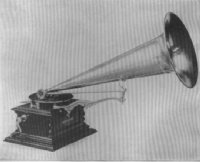One must know that sound is a series of vibrations, or waves of the air. When one talks, thousands of waves agitate the ether, the same as water is disturbed when a stone, is dropped into it. Edison worked on the principle that these soundwaves were powerful enough to inscribe themselves in records, if given the proper opportunity. After a great many crude experiments, the phonograph was the result. This instrument consists of a machine upon which revolves a wax cylinder. Elevated over the cylinder and moving along its distance as the machine is set in motion, is a funnel which gathers up the sound waves. At the end of this funnel is a small drum-like affair made of thin metal, upon which is fastened a tiny stylus or pen. When sound is directed into the funnel, it agitates the drum membrane, which in turn moves the stylus very slightly, and this in turn scratches a record of the waves into the wax of the cylinder. Each sound wave has a peculiar motion unlike any other. Therefore when the cylinder has been revolved its entire distance and the pen has scratched the song into the wax, it should be a perfect record of that song only. Such is the case and now it remains to reproduce the sound. Another drum is attached which has a reproducing stylus similar to the recording one, but of a nature that will not scratch. This pen runs along into all the little scratches made in the record, and agitates the drum membrane in just the reverse manner that it was agitated when the sounds were sent into the funnel at first. Naturally enough this agitation causes the metal drum to give off sounds that very closely imitate those that first went into the phonograph. The motive power to revolve the cylinder is generally developed from a small electric battery attached to it, although clock work will run one for a few minutes. In 1888, Edison, in commenting on the origin of the phonograph, called attention to the well known effects of certain musical notes and chords, upon sand loosely sprinkled upon a sounding board. He showed how the sand sifts itself into various geometric, curves, differing according to pitch and intensity. He alluded to the fine line of sand left high upon an ocean beach, as each breaker spends its force and then recedes. Continuing, he said: "Yet, well known as these phenomena are, they apparently never suggested until within a few years, that the sound waves set going by the human voice might be so directed as to trace an impression upon some solid substance, with a nicety equal to that of the tide in recording its flow upon the sand beach. * * * "My own discovery that this could be done came to me almost accidentally, while I was engaged upon a machine intended to repeat Morse characters which were recorded on paper. "In manipulating this paper, I found that when the indented paper was turned with great swiftness, it gave off a humming noise from the indentations, a musical, rhythmic sound resembling that of human talk heard indistinctly. "This led me to try fitting a diaphram to the machine." DRIVING MECHANISM OF THE HORSELESS VEHICLE |
